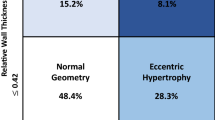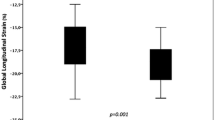Abstract
Objective: Of this study was to investigate three groups of highly trained competitive endurance athletes consisting of marathon runners, triathletes and cyclists for differences in left ventricular adaptation. Methods: 25 marathon athletes, 21 triathlon athletes and 38 cyclists underwent a standard echocardiographic and Doppler study. Results: The left ventricular internal diameter in diastole divided by body surface area was significantly larger in cyclists than in marathon runners (31.6 ± 3.0 vs. 30.0 ± 2.0 mm/m2, p < 0.05) but did not differ of that of triathletes. Left ventricular mass was significantly different between marathon runners and triathletes (253.6 ± 63.7 vs. 322.0 ± 62.1 g, p < 0.005) and between marathon runners and cyclists (253.6 ± 63.7 vs. 314.2 ± 79.2 g, p < 0.005). Systolic wall stress was significantly different between the marathon runners and the triathletes (88.4 ± 11.7 vs. 78.9 ± 11.0 g/cm2 p < 0.05). Only a minority of the endurance athletes showed concentric remodeling (7%), whereas a majority showed eccentric remodeling (65%) of the left ventricle. The prevalence of eccentric remodeling was more apparent in cyclists. There were some specific differences in left ventricular diastolic function between the three different endurance sports, but no left ventricular diastolic dysfunction could be detected. Conclusion: There is a sport-specific left ventricular adaptation in endurance athletes. The triathlon heart and the heart of a cyclist differ significantly from a marathon heart.
Similar content being viewed by others
References
Schaier J, Stein P, Keteyian S, Fedel F, Ehrman J, Alam M. Left ventricular response to submaximal exercise in endurance trained athletes and sedentary adults. Am J Cardiol 1992; 70: 930–933.
Shapiro L. Morphologic consequences off systematic training. In: Cardiology Clinics Philadelphia. Saunders vol. 10, 1992; 219–226.
Maron BJ, Structural features of the athlete heart as defined by echocardiography. J Am Coll Cardiol 1986; 7: 190–203.
Levine B, Lane L, Buckey J, Friedman D, Blomqvist G. Left ventricular pressure volume and Frank-Starling relations in endurance athletes. Circulation 1991; 84: 1016–1023.
Colan S, Sanders S, Borow K. Physiologic hypertrophy: effects on left ventricular mechanics in athletes. J Am Coll Cardiol 1987; 9: 776–783.
Palatini P, Mos L, Di Marco A, et al. Intra-arterial blood pressure recording during sports activities. J Hypertens 1987; 5: 479–481.
Mitchell JH. Classification of sports. J Am Cardiol 1994; 24: 864–866.
Fagard R, Aubert A, Staesen J, Van den Eynde E, Van Hees L, Amery A. Cardiac structure and function in cyclists and runners comparative echocardiographic study. Br Heart J 1984; 52: 124–129.
Lauer M, Levy D, Keaven M, Anderson, Plehn J. Is there a relationship between exercise systolic blood pressure response and left ventricular mass? Ann Int Med 1992; 16: 203–210.
Morgenroth J, Maron B, Henry W. Comparative left ventricular dimensions in trained athletes. Ann Intern Med 1975; 82: 521–524.
Nishimura T, Yoshihisa Y, Chiuchi K. Echocardiographic evaluation of long-term effects on left ventricular hypertrophy and function in professional bicyclists. Circulation 1980; 61: 832–840.
Du Bois D, Du Bois EF. Measurement of surface area in man. Arch Int Med 1915; 15: 868–881.
Verdecchia P, Schillaci G, Borgioni G, et al. Adverse prognostic significance on concentric remodelling of the left ventricle in hypertensive subjects with normal left ventricular mass. J Am Coll Cardiol 1995; 25: 871–878.
Krumholz HM, Larson M, Levy D. Prognosis of left ventricular geometric patterns in Framinham Heart Study. J Am Coll Cardiol 1995; 25: 879–884.
Douglas PS, Reichek N, Hackney K, Ioli A, Sutton MG. Contribution of after load, hypertrophy and geometry to left ventricular ejection fraction in aortic valve stenosis, pure aortic regurgitation and idiopathic dilated cardiomyopathy. Am J Cardiol 1987; 59: 1398–1404.
Reichek N, Wilson J, St John Sutton, Plappert T, Goldberg S, Hirshfeld S. Noninvasive determination of left ventricular end-systolic stress; validation of the method and initial application. Circulation 1982; 65: 99–108.
Devereux RB, Alonso D, Lutas E, Gottlieb G, Campo E, Sachs I. Echocardiographic assessment of left ventricular hypertrophy: comparison to necropsy findings. Am J Cardiol 1986; 57: 450–458.
Devereux RB, Reichek N. Echocardiographic determination of left ventricular mass in man. Circulation 1977; 55: 613–618.
Feigenbaum H. Echocardiography 5th ed Lea & Febinger, 1994; 676–677.
Colan S. Mechanics of left ventricular systolic and diastolic function in physiologic hypertrophy of the athlete's heart. In: Crawford M editor. Cardiology Clinics Saunders W.B, 1997; 355–372.
Fagard R, Van den Broeke C, Vanhees L, et al. Non-invasive assessment of systolic and diastolic left ventricular function in female runners. Eur Heart J 1987; 8: 1305.
Fagard R, Van den Broeke C, Amery A. Left ventricular dynamics during exercise in elite marathon runners. J Am Coll Cardiol 1989; 14: 112.
Douglas P, O'Toole M, Katz S, Ginsburg G, Douglas W, Laird R. Left ventricular hypertrophy in athletes. Am J Cardiol 1997; 80: 1384–1388.
Pluim B, Zwinderman A, van der Laarse A, van der Wall E. The athlete's heart a meta-analysis of cardiac structure and function. Circulation 1999; 100: 336–344.
Snoeckx L, Abeling H, Lambrechts J, Schmitz J, Verstappen F, Reneman R. Cardiac dimensions in athletes in relation to variation in their training programs. Eur J Appl Physiol 1983; 52: 20–28.
Colan S, Sanders S, MacPhierson D, Borow K. Left ventricular diastolic function in elite athletes with physiologic cardiac hypertrophy. J Am Coll Cardiol 1985; 6: 545–549.
Galanti G, Comeglio M, Vinci M, Capelli B, Vono M, Bamoshmoosh M. Echocardiographic Doppler evaluation of left ventricular diastolic function in athletes hypertrophic hearts. Angiol J Vasc Diseases 1993; 44: 341–356.
Harrison M, Clifton GD, Penell AT, Demaria AN. Effect of heart rate on left ventricular diastolic transmitral flow velocity patterns assessed by Doppler echocardiography in normal subjects. Am J Cardiol 1991; 67: 622–627.
Douglas P, O'Toole M, Douglas W, Hiller B, Reichek N. Left ventricular structure and function by echocardiography in ultra endurance athletes. Am J Cardiol 1986; 58: 805–809.
Author information
Authors and Affiliations
Rights and permissions
About this article
Cite this article
Hoogsteen, J., Hoogeveen, A., Schaffers, H. et al. Myocardial adaptation in different endurance sports: an echocardiographic study. Int J Cardiovasc Imaging 20, 19–26 (2004). https://doi.org/10.1023/B:CAIM.0000013160.79903.19
Issue Date:
DOI: https://doi.org/10.1023/B:CAIM.0000013160.79903.19




